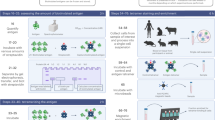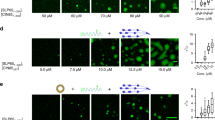Abstract
Soluble antigen binds to the B-cell antigen receptor and is internalized for subsequent processing and the presentation of antigen-derived peptides to T cells1. Many antigens are not soluble, however, but are integral components of membrane; furthermore, soluble antigens will usually be encountered in vivo in a membrane-anchored form, tethered by Fc or complement receptors2,3,4. Here we show that B-cell interaction with antigens that are immobilized on the surface of a target cell leads to the formation of a synapse and the acquisition, even, of membrane-integral antigens from the target. B-cell antigen receptor accumulates at the synapse, segregated from the CD45 co-receptor which is excluded from the synapse, and there is a corresponding polarization of cytoplasmic effectors in the B cell. B-cell antigen receptor mediates the gathering of antigen into the synapse and its subsequent acquisition, thereby potentiating antigen processing and presentation to T cells with high efficacy. Synapse formation and antigen acquisition will probably enhance the activation of B cells at low antigen concentration, allow context-dependent antigen recognition and enhance the linking of B- and T-cell epitopes.
This is a preview of subscription content, access via your institution
Access options
Subscribe to this journal
Receive 51 print issues and online access
$199.00 per year
only $3.90 per issue
Buy this article
- Purchase on Springer Link
- Instant access to full article PDF
Prices may be subject to local taxes which are calculated during checkout





Similar content being viewed by others
References
Lanzavecchia, A. Antigen-specific interaction between T and B cells. Nature 314, 537– 539 (1985).
Klaus, G. G., Humphrey, J. H., Kunkl, A. & Dongworth, D. W. The follicular dendritic cell: its role in antigen presentation in the generation of immunological memory. Immunol. Rev. 53, 3– 28 (1980).
Tew, J. G., Kosco, M. H., Burton, G. F. & Szakal, A. K. Follicular dendritic cells as accessory cells. Immunol. Rev. 117, 185– 211 (1990).
Kosco-Vilbois, M. H., Gray, D., Scheidegger, D. & Julius, M. Follicular dendritic cells help resting B cells to become effective antigen-presenting cells: induction of B7/BB1 and upregulation of major histocompatibility complex class II molecules. J. Exp. Med. 178, 2055– 2066 (1993).
Schamel, W. W. & Reth, M. Monomeric and oligomeric complexes of the B cell antigen receptor. Immunity 13, 5– 14 (2000).
Taylor, R. B., Duffus, W. P. H., Raff, M. C. & de Petris, S. Redistribution and pinocytosis of lymphocyte surface immunoglobulin molecules induced by anti-immunoglobulin antibody. Nature 233, 225– 227 (1971).
Schreiner, G. F. & Unanue, E. R. Capping and the lymphocyte: models for membrane reorganisation. J. Immunol. 119, 1549– 1551 (1977).
Cheng, P. C., Dykstra, M. L., Mitchell, R. N. & Pierce, S. K. A role for lipid rafts in B cell antigen receptor signaling and antigen targeting. J. Exp. Med. 190, 1549– 1560 (1999).
Weintraub, B. C. et al. Entry of B cell receptor into signaling domains is inhibited in tolerant B cells. J. Exp. Med. 191, 1443– 1448 (2000).
Batista, F. D. & Neuberger, M. S. Affinity dependence of the B cell response to antigen: a threshold, a ceiling, and the importance of off-rate. Immunity 8, 751– 759 (1998).
Nemazee, D. & Burki, K. Clonal deletion of B lymphocytes in a transgenic mouse bearing anti-MHC class I antibody genes. Nature 337, 562– 566 (1989).
Hartley, S. B. et al. Elimination from peripheral lymphoid tissues of self-reactive B lymphocytes recognizing membrane-bound antigens. Nature 353, 765– 769 (1991).
Dustin, M. L. et al. Low affinity interaction of human and rat T cell adhesion molecule CD2 with its ligands aligns adhering membranes to achieve high physiological affinity. J. Biol. Chem. 272, 30889– 30898 (1997).
Lang, J. et al. B cells are exquisitely sensitive to central tolerance and receptor editing by ultralow affinity, membrane-bound antigen. J. Exp. Med. 184, 1685– 1697 (1996).
Valitutti, S., Muller, S., Cella, M., Padovan, E. & Lanzavecchia, A. Serial triggering of many T-cell receptors by a few peptide–MHC complexes. Nature 375, 148– 151 (1995).
Monks, C. R., Freiberg, B. A., Kupfer, H., Sciaky, N. & Kupfer, A. Three-dimensional segregation of supramolecular activation clusters in T cells. Nature 395, 82– 86 (1998).
Wulfing, C. & Davis, M. M. A receptor/cytoskeletal movement triggered by costimulation during T cell activation. Science 282, 2266– 2269 (1998).
Grakoui, A. et al. The immunological synapse: a molecular machine controlling T cell activation. Science 285, 221– 227 (1999).
Leupin, O., Zaru, R., Laroche, T., Muller, S. & Valitutti, S. Exclusion of CD45 from the T-cell receptor signaling area in antigen-stimulated T lymphocytes. Curr. Biol. 10, 277– 280 (2000).
Cagan, R. L., Kramer, H., Hart, A. C. & Zipursky, S. L. The bride of sevenless and sevenless interaction: internalization of a transmembrane ligand. Cell 69, 393– 399 (1992).
Huang, J. F. et al. TCR-mediated internalization of peptide–MHC complexes acquired by T cells. Science 286, 952– 954 (1999).
Hwang, I. et al. T cells can use either T cell receptor or CD28 receptors to absorb and internalize cell surface molecules derived from antigen-presenting cells. J. Exp. Med. 191, 1137– 1148 (2000).
Batista, F. D. & Neuberger, M. S. B cells extract and present immobilized antigen: implications for affinity discrimination. EMBO J. 19, 513– 520 (2000).
Casten, L. A., Lakey, E. K., Jelachich, M. L., Margoliash, E. & Pierce, S. K. Anti-immunoglobulin augments the B-cell antigen-presentation function independently of internalization of receptor-antigen complex. Proc. Natl Acad. Sci. USA 82, 5890– 5894 (1985).
Siemasko, K., Eisfelder, B. J., Williamson, E., Kabak, S. & Clark, M. R. Signals from the B lymphocyte antigen receptor regulate MHC class II containing late endosomes. J. Immunol. 160, 5203– 5208 (1998).
Serre, K. et al. Efficient presentation of multivalent antigens targeted to various cell surface molecules of dendritic cells and surface Ig of antigen-specific B cells. J. Immunol. 161, 6059– 6067 (1998).
Green, S. M., Lowe, A. D., Parrington, J. & Karn, J. Transformation of growth factor-dependent myeloid stem cells with retroviral vectors carrying c-myc. Oncogene 737– 751 (1989).
Russell, D. M. et al. Peripheral deletion of self-reactive B cells. Nature 354, 308– 311 (1991).
Goodnow, C. C. et al. Altered immunoglobulin expression and functional silencing of self-reactive B lymphocytes in transgenic mice. Nature 334, 676– 682 (1988).
Aluvihare, V. R., Khamlichi, A. A., Williams, G. T., Adorini, L. & Neuberger, M. S. Acceleration of intracellular targeting of antigen by the B-cell antigen receptor: importance depends on the nature of the antigen-antibody interaction. EMBO J. 16, 3553– 3562 (1997).
Acknowledgements
We thank B. Amos and S. Reichelt for help and advice with confocal microscopy, and S. Munro for helpful discussions. We are indebted those who provided antibodies, transgenic mice and cell lines. F.D.B. and D.I. were supported by the Arthritis Research Campaign and Studienstiftung des deutschen Volkes, respectively.
Author information
Authors and Affiliations
Corresponding authors
Supplementary information
Supplement to Figure 2(d)
Polarisation of actin (stained with phalloidin), phospholipase Cg2 (PLCg2) and ganglioside GM1 (stained with cholera toxin B subunt, CTB) in HEL-specific B cells interacting with J[mHEL]6 targets. In each case, a single confocal section is shown in single or merged channel viewing.
Movie 1
Rotation of a 3D projection of HEL-specific splenic B cells that have been incubated for 10 min at 37 oC with J[mHEL]6 targets prior to fixation, permeabilisation and staining for IgM (red) and HEL (green).
Movie 2
Rotation of a 3D projection of HEL-specific splenic B cells that have been incubated for 60 min at 37 oC with J[mHEL]6 targets prior to fixation, permeabilisation and staining for IgM (red) and HEL (green). Following this longer incubation, transfer is observed of HEL to the B cell where it colocalises with IgM.
Rights and permissions
About this article
Cite this article
Batista, F., Iber, D. & Neuberger, M. B cells acquire antigen from target cells after synapse formation. Nature 411, 489–494 (2001). https://doi.org/10.1038/35078099
Received:
Accepted:
Issue Date:
DOI: https://doi.org/10.1038/35078099
This article is cited by
-
Enhancing antibody responses by multivalent antigen display on thymus-independent DNA origami scaffolds
Nature Communications (2024)
-
Recreation of an antigen-driven germinal center in vitro by providing B cells with phagocytic antigen
Communications Biology (2023)
-
Continually recruited naïve T cells contribute to the follicular helper and regulatory T cell pools in germinal centers
Nature Communications (2023)
-
Molecular basis for potent B cell responses to antigen displayed on particles of viral size
Nature Immunology (2023)
-
Multivalent virus-like epitope display amplifies BCR signaling independent of avidity
Nature Immunology (2023)
Comments
By submitting a comment you agree to abide by our Terms and Community Guidelines. If you find something abusive or that does not comply with our terms or guidelines please flag it as inappropriate.



